We closed this position on August 20, 2021. A copy of the associated Position Update report is here.
Check out this week’s Danger Zone Interview with Chuck Jaffe of Money Life.
As the S&P 500 has rallied ~43% since March 23, investors need to focus on individual stocks to generate meaningful returns going forward. This industry-leading apparel company has the cash flows and balance sheet to survive the downturn and is well-positioned to grow profits during the economic recovery. Those overlooking PVH Corp (PVH: $64/share) are in the Danger Zone. Investors willing to look past the dip in economic activity can find great value in this Long Idea.
PVH Corp’s History of Profit Growth
Prior to the COVID-19 outbreak, PVH Corp had a strong history of profit growth. Since 2009, PVH Corp grew revenue by 15% compounded annually and core earnings[1] by 14% compounded annually, per Figure 1. Longer term, PVH Corp has grown core earnings by 18% compounded annually over the past two decades. The firm increased its core earnings margin year-over-year (YoY) in 14 of the past 20 years and its core earnings margin of 6% over the trailing-twelve-months (TTM) is up from 2% in 1999.
Figure 1: Core Earnings & Revenue Growth Since 2009
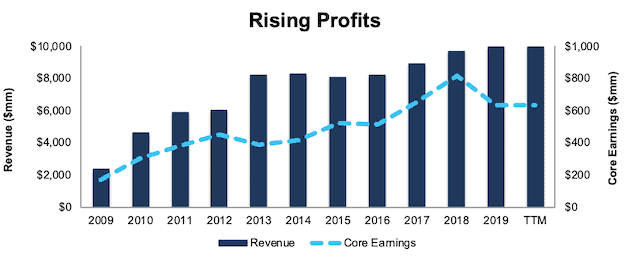
Sources: New Constructs, LLC and company filings
PVH Corp’s rising profitability helps the business generate significant free cash flow (FCF). The company generated positive FCF in eight of the past 10 years and a cumulative $3.0 billion (67% of market cap) over the past five years. PVH Corp’s $641 million in FCF over the TTM period equates to a 6% FCF yield, which is significantly higher than the Consumer Cyclicals sector average of 2%.
PVH Corp’s Balance Sheet Provides Ample Liquidity to Survive the Crisis
On April 6, 2020, PVH Corp announced that it had ~$1.3 billion of cash and available borrowings. On April 24, the firm further increased its available liquidity to $1.5 billion after closing its 175 euro 2024 notes offering. Additionally, the firm’s debt maturity profile lends itself well to weather the current downturn. After the firm pays $14 million due this year, it does not have another debt maturity until 2023.
Furthermore, the firm is taking measures to reduce its costs during difficult times:
- suspended dividend payments and share repurchases
- reduced the salaries for over 250 executives and senior leaders by up to 50%
- begun actions that will result in ~75% of store, office, and warehouse associates being furloughed or having working hours decreased
- temporarily reduced salaries for associates in Asia
- reduced discretionary operating and marketing expenses
- reduced capital expenditures from $345 million last year to $190 million this year
If we assume PVH Corp’s revenue falls to zero, and the firm is able to reduce its SG&A expenses by 10%, the firm would be able to operate for nearly four months before needing to raise additional capital. This scenario illustrates the firm’s strong cash position. It is also highly unlikely since 1075 stores in Asia Pacific, 350 stores in Europe, 180 of its stores in North America, and 75 stores in Brazil are open as of May 19, 2020.
If we assume an extremely adverse scenario where PVH Corp’s revenue falls 60% (compared to McKinsey & Company's 2020 industry estimated decline of 30%), gross margin falls to 30% (all-time company low in 1998 compared to 54% TTM), and SG&A expenses are reduced by 10%, the firm will generate only $4 billion in revenue. When added to $1.5 in available liquidity, and after paying down $144 million of notes due this year and making $190 million of capital expenditures, the firm could operate for nearly nine months before needing to raise additional capital.
PVH Corp is Closing the Gap with Competitors
Before the current crisis, PVH Corp’s profitability was trending higher and at a faster pace than its competitors. This improved profitability is a testament to PVH Corp’s strong business model, which leverages its economies of scale across the global apparel industry. Improved profitability also provides PVH Corp with greater resources to survive the current downturn, while also benefiting from the economic bounce back once we’re clear of the COVID-19 constraints on economic activity.
Per Figure 2, PVH Corp’s net operating profit after-tax (NOPAT) margin has improved from 8% in 2015 to 9% TTM. Meanwhile, the market-cap-weighted average of PVH Corp’s peers has fallen from 12% to 11% over the same time. Peers in the group include 14 Textiles & Apparel companies that own or manage brands and primarily engage in selling apparel. These include VF Corporation (VFC), Hanesbrands Inc. (HBI), Levi Strauss & Co (LEVI), and Ralph Lauren Corp (RL) among others. The peer group does not include companies primarily engaged in footwear and fashion accessories.
Figure 2: NOPAT Margin Vs. Competitors

Sources: New Constructs, LLC and company filings.
PVH Corp has focused on making its supply chain faster and more responsive. If successful, we would expect to see the firm more efficiently allocate capital. PVH Corp’s invested capital turns, a measure of balance sheet efficiency, while below the market-cap-weighted average of peers, have improved from 0.7 in 2015 to 0.8 TTM. The peer average has declined from 1.2 to 1.1 over the same time.
Figure 3: Invested Capital Turns vs. Competitors

Sources: New Constructs, LLC and company filings.
The combination of rising margins and invested capital turns drives PVH Corp’s ROIC higher. PVH Corp has improved its ROIC from 5% in 2015 to 7% TTM. Per Figure 4, the market-cap-weighted average ROIC of peers has decreased from 13% to 11% over the same time.
Figure 4: ROIC vs. Competitors

Sources: New Constructs, LLC and company filings.
PVH Corp’s improving profitability shows that its investments in marketing its core brands, growing its digital commerce channel, and enhancing supply chain efficiencies give it a competitive advantage. Moving forward, PVH Corp’s improved profitability allows the firm to survive the current downturn and better adapt to decreased demand in the apparel sector.
Bear Case Assumes Apparel Industry Never Recovers
There’s no denying that the COVID-19 pandemic, has, and will, alter the apparel industry. PVH Corp, along with everyone else in the industry will certainly feel some pain.
Naturally, we expect PVH Corp’s sales to decline sharply in the short term, but we, along with the International Monetary Fund (IMF) and nearly every economist in the world, believe that the global economy grows strongly in 2021. A global economic recovery will include recovery in the global apparel industry.
To believe that the global apparel industry will be in permanent decline ignores the expectations for an industry recovery. The global apparel market is forecasted to decline by 15.2% in 2020 and is “not expected to return or exceed its 2019 value, until at least 2022.” The key point of that forecast is that the industry will rebound back to current levels within a few years. After the rebound, experts expect the industry to return to growth at a compounded annual growth rate of 5.5% from 2020 to 2025.
In any recovery scenario, PVH Corp’s core brands, Tommy Hilfiger and Calvin Klein which both rank among 20 of the most successful American fashion brands, are well-positioned to take advantage of the rising demand.
Combined, these brands comprise 85% of the firm’s total revenue. Per Figure 5, revenue from Tommy Hilfiger and Calvin Klein has increased by 6% and 5% compounded annually over the past five years. It seems unlikely that demand for PVH Corp’s core brands will disappear given their strong historical growth and appeal to customers globally.
Figure 5: Increased Demand for PVH Corp’s Core Brands

Sources: New Constructs, LLC and company filings
While PVH Corp’s core brands’ share of the global clothing and apparel market fell slightly from 1.13% in 2014 to 1.06% in 2018, more recently, PVH Corp’s core brands’ revenue growth has outpaced the revenue growth of 30 different Textile & Apparel firms, which account for over $326 billion of market cap or 43% of the industry’s 2018 value. PVH’s core brands’ share of the group’s aggregate revenue increased from 5.5% in 2015 to 6.2% in 2019. At just 6.2% of the peer group’s revenue, Tommy Hilfiger and Calvin Klein have plenty of room to take more market share from competitors.
All of the long-term effects of COVID-19 on the apparel industry are unknown, but we do know that many of PVH Corp’s competitors are under great financial strain. J. Crew Group, Inc. has already filed for bankruptcy, and Tailored Brands Inc. (TLRD) is considering bankruptcy. These two firms’ sales had been struggling for years before the recent crisis hit. Since 2014, the combined revenue of these firms fell from $5.8 billion to $5.4 billion in 2019, or a compounded annual decline of 1.5%. Much of the failing firms’ combined $5.4 billion of revenue, which is 55% of PVH Corp’s 2019 revenue, will likely be up for grabs by their stronger competitors as J. Crew and Tailored Brands likely reorganize into smaller operations.
Steady Performance with Room to Grow
PVH Corp’s core brands have consistently grown revenue since PVH Corp acquired Tommy Hilfiger in 2010. Per Figure 6, the firm grew its core brands’ revenue by over 9% compounded annually since 2011 and achieved positive year-over-year revenue growth in seven of the last eight years.
Figure 6: Tommy Hilfiger & Calvin Klein Revenue Since 2010
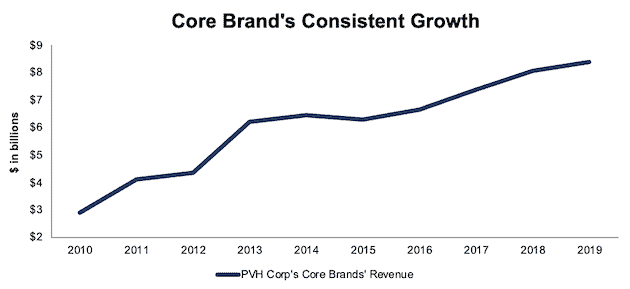
Sources: New Constructs, LLC and company filings
PVH Corp’s Core Brands Have Plenty of Opportunities to Maintain Their Steady Growth as Well
Tommy Hilfiger is focused on expanding into two new opportunities to continue to grow its business. Last year, it launched Tommy Sport as a way to meet the growing demand for active living apparel by “injecting a cool and bold edge into performance.” While expanding into the active wear market, Tommy Hilfiger has also been meeting the growing demand for environmentally-friendly apparel. The brand introduced denim products made from 100% recycled cotton and stitched with thread made from 100% recycled plastic bottles. For comparison, H&M’s recycled denim line contains just 20% recycled cotton.
Calvin Klein uses a tiered marketing strategy utilizing its various brands – CK Calvin Klein, Calvin Klein, Calvin Klein Jeans, Calvin Klein Underwear, and Calvin Klein Performance. This strategy has been effective in consistently growing revenue domestically and internationally by targeting multiple distribution channels at a variety of price points. Calvin Klein’s multiple tiers provide the brand flexibility to take advantage of whatever the next fashion trends may be.
Beyond Brick and Mortar Retail
Investors may be quick to dismiss PVH Corp’s long-term potential due to its significant retail storefront business. While the retail apocalypse may be real for many weaker firms, it is not so much for stronger operators. The firm’s retail revenue has grown 6% compounded annually since 2016.
PVH Corp’s revenue is comprised of much more than just retail as well. Per Figure 7, PVH Corp generated 56% of its 2019 revenue from non-retail channels.
Figure 7: PVH Corp’s Diversified Revenue Channels
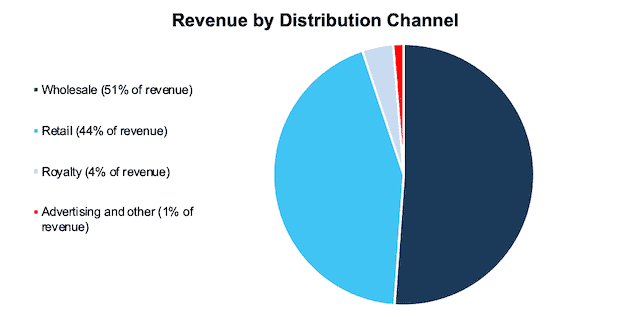
Sources: New Constructs, LLC and company filings
PVH Corp has made a substantial commitment to its digital commerce channel as well. Last year, the firm’s digital sales represented 12% of the firm’s total revenue (up from 10% in 2018) and grew 20% year-over-year (YoY).
PVH Trades at Cheapest Level in Years
After falling 40% YTD to $64/share, PVH now trades significantly below its economic book value and at its cheapest price-to-economic book value (PEBV) ratio (0.4) in the history of our model. This ratio means the market expects PVH Corp’s NOPAT to permanently decline by 60%. This expectation seems overly pessimistic over the long term. For reference, after NOPAT fell 11% YoY in 2009 (during the last economic downturn), the firm grew NOPAT by 35% compounded annually over the following four years.
PVH Corp’s current economic book value, or no-growth value, is $164/share – 156% upside to the current price.
Figure 8: Stock Price vs. Economic Book Value (EBV)
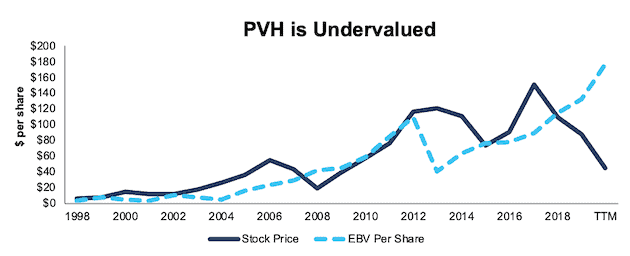
Sources: New Constructs, LLC and company filings.
PVH is not just historically cheap against its own economic book value, but also relative to industry peers.
Numerous case studies show that getting ROIC right is an important part of making smart investments. This paper compares our analytics on a mega cap company to Bloomberg and Capital IQ (SPGI) in a detailed appendix. The technology that enables this research is featured by Harvard Business School.
Per Figure 9, ROIC explains 70% of the difference in valuation for 30 different Textiles & Apparel companies. PVH trades at a discount to the group as shown by its position below the trend line.
Figure 9: ROIC Explains 70% of Difference in Valuation for PVH Corp’s Peers
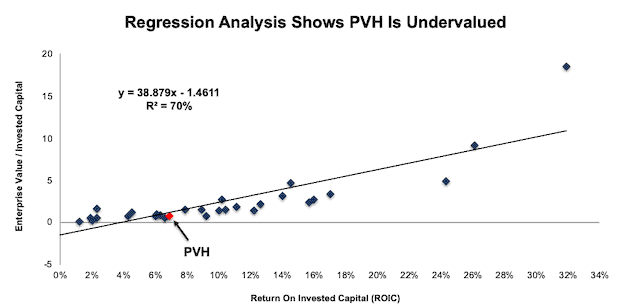
Sources: New Constructs, LLC and company filings.
If the stock were to trade at parity with its peers, it would be worth $144/share – 125% above the current stock price.
PVH’s undervaluation is further highlighted when we narrow in on just 14 of the above businesses that are most similar to PVH Corp. These businesses own or manage brands and primarily engage in selling apparel. This list excludes companies primarily engaged in selling footwear and fashion accessories. Per Figure 10, PVH trades at an even bigger discount to this group as shown by its position below the trend line.
Figure 10: ROIC Explains 53% of Difference in Valuation for PVH Corp’s Most Closely Related Peers
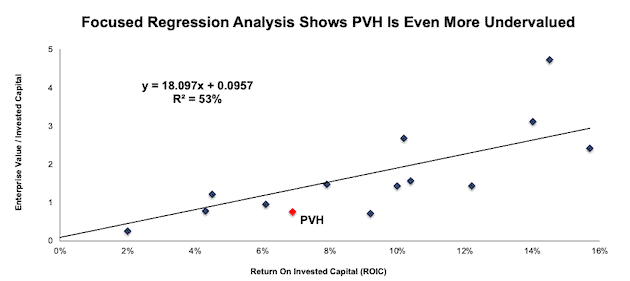
Sources: New Constructs, LLC and company filings.
If the stock were to trade at parity with its peers, it would be worth $166/share – 159% above the current stock price. Given the consistent revenue growth of its core brands, relative size to its peers, and recent improvement in profitability, PVH deserves a premium valuation to its peers.
PVH Corp’s Current Price Implies Worst-Case Scenario
Below, we use our reverse DCF model to quantify the cash flow expectations baked into PVH Corp’s current stock price. Then, we analyze the implied value of the stock based on different assumptions about COVID-19’s impact on the apparel industry and PVH Corp’s future growth in cash flows.
Scenario 1: Using industry projections, PVH Corp’s current revenue, and its historical margins, we can model the worst-case scenario already implied by PVH Corp’s current stock price. In this scenario, we assume the following:
- NOPAT margins fall to 3% (all-time company low in 2010, compared to 9% TTM) in 2020 and 2021 and rise to 7% in each year thereafter (all-time company average)
- Sales fall 30% in 2020 (McKinsey & Company industry estimate) and do not grow in the following year
- Sales begin growing again in 2022 but only at 3.5% a year, which equals the average global GDP growth rate since 1961
In this scenario, where PVH Corp’s NOPAT declines 2% compounded annually for the next thirteen years (including a 77% YoY decline in 2020), the stock is worth $64/share today – equal to the current stock price. This scenario accounts for the debt issuance after FYE 2020 noted earlier. We conservatively assume this capital will be used to cover operating expenses and do not treat it as excess cash. See the math behind this reverse DCF scenario.
Figure 11 compares the firm’s implied future NOPAT to its historical NOPAT in this scenario. This worst-case scenario implies PVH Corp’s NOPAT thirteen years from now will be 21% below its 2019 NOPAT. In other words, this scenario implies that thirteen years after the COVID-19 pandemic, PVH Corp’s profits will have recovered to just 9% above 2016 profit levels and 15% below 2017 profit levels. In any scenario better than this one, PVH holds significant upside potential, as we’ll show below.
Figure 11: Current Valuation Implies Severe, Long-Term Decline in Profits: Scenario 1
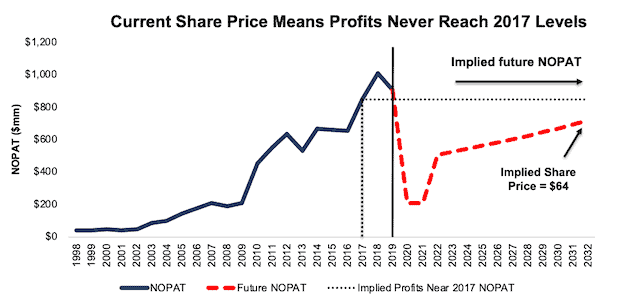
Sources: New Constructs, LLC and company filings.
Scenario 2: Cheap Valuation Provides Significant Upside
If we assume, as does the IMF in its base case for GDP growth, that the pandemic threat is lessened in the second half of the year and the global economy grows strongly in 2021, PVH looks even more undervalued.
In this scenario, we assume:
- NOPAT margins fall to 3% (all-time company low in 2010, compared to 9% TTM) in 2020 and rise to 8% (five-year company low) in each year thereafter
- Sales fall 30% in 2020 (McKinsey & Company industry estimate) before growing at consensus estimates of 15.3% in 2021 and 6.9% in 2022
- Sales grow at 3.5% a year from 2023 onward, which equals the average global GDP growth rate since 1961
In this scenario, PVH Corp’s NOPAT declines by less than 1% compounded annually over the next decade (including a 77% YoY decline in 2020), and the stock is worth $97/share today – a 52% upside to the current price. This scenario accounts for the debt issuance after FYE 2020 noted earlier. We conservatively assume this capital will be used to cover operating expenses and do not treat it as excess cash. See the math behind this reverse DCF scenario.
It’s not often investors get the opportunity to buy an industry leader at such a discounted price.
Figure 12 compares the firm’s implied future NOPAT to its historical NOPAT in scenario 2. This scenario implies PVH Corp’s NOPAT a decade from now will be 4% below its 2019 NOPAT. In other words, this scenario implies that 10 years after the COVID-19 pandemic, PVH Corp’s profits will have recovered to ~2017 profit levels.
Figure 12: Implied Profits Assuming Moderate Recovery in 2021: Scenario 2
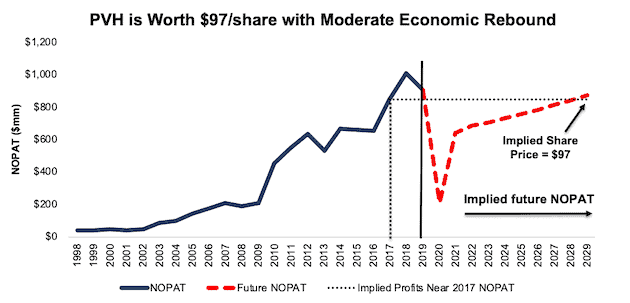
Sources: New Constructs, LLC and company filings.
Sustainable Competitive Advantages Will Drive Shareholder Value Creation
Here’s a summary of why we think the moat around PVH Corp’s business will enable it to continue to generate higher NOPAT than the current market valuation implies. The following competitive advantages help PVH Corp’s profitability reach customers and prevent competition from taking market share:
- Improving profitability while competitors’ is falling
- Strong global brands in Tommy Hilfiger and Calvin Klein positioned to grow market share
- Economies of scale from efficient supply chain management
- Ample liquidity to survive downturn
What Noise Traders Miss with PVH Corp
These days, fewer investors focus on finding quality capital allocators with shareholder friendly corporate governance. Instead, due to the proliferation of noise traders, the focus is on short-term technical trading trends while high-quality fundamental research is overlooked. Here’s a quick summary of what noise traders are missing:
- Core earnings and free cash flow generation over the past decade
- Industry leader in a great position to excel after the global pandemic subsides
- Valuation implies the economy never fully recovers from COVID-19
Suspended Dividend Should Be Temporary
As noted above, PVH Corp management suspended its quarterly dividend to maintain flexibility and liquidity during the current economic downturn. Prior to this suspension, PVH’s dividend provided a 1.8% yield. In large part due to its strong cash generation, we expect the current suspension to be temporary.
Over the past five years, PVH Corp has generated more in free cash flow than it has paid in dividends. PVH Corp generated a cumulative FCF of $3.0 billion over the past five years and paid out $60 million in dividends over the same time. FCF exceeded dividend payments by an average of $595 million per year over this time.
Firms with cash flows greater than dividend payments have a higher likelihood to maintain and grow dividends. While PVH Corp suspended its dividend in the short term, investors buying at current prices should get a nice yield with upside potential as PVH Corp reinstates the dividend over the long term.
In addition to dividends, PVH has returned capital to shareholders through share repurchases. The firm repurchased $1.7 billion worth of shares over the past five years. Prior to suspending repurchases, PVH Corp was authorized to repurchase up to $683 million more worth of shares. When the firm restarts share repurchases once the crisis is over, the yield for investors will only increase.
An Earnings Beat of Depressed Expectations Could Send Shares Higher
According to Zacks, consensus estimates at the end of February pegged PVH Corp’s 2020 earnings at $9.37/share. Jump forward to June 8, and consensus estimates for PVH Corp’s 2020 earnings have fallen to just $2.52/share.
While the short-term impact of the COVID-19 pandemic is yet to be seen, these lowered expectations provide a great opportunity for a high-quality business, such as PVH Corp, to beat consensus estimates. In addition to lowered expectations, our current Earnings Distortion Score for PVH Corp is “Beat,” which indicates the firm is likely to beat consensus expectations in the coming quarter. Should PVH Corp beat earnings estimates again, as it has in 11 of the past 12 quarters, shares could rise higher.
Executive Compensation Plan Could Be Improved
79% to 90% of PVH Corp’s executives’ total compensation is deemed “at-risk.” Annual bonuses are linked to EPS for all NEOs and executives with divisional responsibilities also have business unit operating income goals linked to their bonuses. In addition to annual bonuses, the firm also compensates executives with performance share units (PSUs) that are linked to absolute stock price growth and relative total shareholder return goals.
We would prefer PVH Corp use a compensation plan that is tied to ROIC improvement as there is a strong correlation between improving ROIC and increasing shareholder value.
Despite using different, and sometimes damaging, metrics such as total shareholder return and EPS, PVH Corp’s plan has not compensated executives while destroying shareholder value. PVH Corp has grown economic earnings by 98% compounded annually over the past four years and 8% compounded annually over the past decade.
Insider Trading and Short Interest Trends
Over the past 12 months, insiders have purchased a total of 366 thousand shares and sold 26 thousand shares for a net effect of 340 thousand shares purchased. These purchases represent less than 1% of shares outstanding.
There are currently 4.2 million shares sold short, which equates to 6% of shares outstanding and two days to cover. Short interest is up 7% from the prior month, which indicates investors are too focused on the dip and not the recovery afterwards.
Critical Details Found in Financial Filings by Our Robo-Analyst Technology
As investors focus more on fundamental research, research automation technology is needed to analyze all the critical financial details in financial filings as shown in the Harvard Business School and MIT Sloan paper, "Core Earnings: New Data and Evidence”.
Below are specifics on the adjustments we make based on Robo-Analyst findings in PVH Corp’s 2019 10-K:
Income Statement: we made $614 million of adjustments with a net effect of removing $486 million in non-operating expenses (<1% of revenue). See all adjustments made to PVH Corp’s income statement here.
Balance Sheet: we made $2.0 billion of adjustments to calculate invested capital with a net increase of $939 million. One of the most notable adjustments was $691 million (6% of reported net assets) in other comprehensive income. See all adjustments to PVH Corp’s balance sheet here.
Valuation: we made $5.7 billion of adjustments with a net effect of decreasing shareholder value by $5.3 billion. Apart from total debt, the most notable adjustment to shareholder value was $518 million in deferred tax liabilities. This adjustment represents 15% of PVH Corp’s market cap. See all adjustments to PVH Corp’s valuation here.
Attractive Funds That Hold PVH
The following funds receive our Attractive-or-better rating and allocate significantly to PVH:
- John Hancock Classic Value Fund (PZFVX) – 2.5% allocation and Attractive rating.
- Alpha Architect U.S. Quantitative Value ETF (QVAL) – 2.0% allocation and Very Attractive rating.
This article originally published on June 10, 2020.
Disclosure: David Trainer, Kyle Guske II, and Matt Shuler receive no compensation to write about any specific stock, style, or theme.
Follow us on Twitter, Facebook, LinkedIn, and StockTwits for real-time alerts on all our research.
[1] Our core earnings are a superior measure of profits, as demonstrated in In Core Earnings: New Data & Evidence a paper by professors at Harvard Business School (HBS) & MIT Sloan. The paper empirically shows that our data is superior to “Income Before Special Items” and “operating income after depreciation” from S&P Global (SPGI).
